Crane on the heating battery: a description of the technical
If you want to achieve optimum performance of your heating system, then be sure to equip it with special cranes, allowing you to control and optimize the movement of the coolant. What models are used for this, as well as where and how to install them, we will examine in detail in this article.

Ball valve
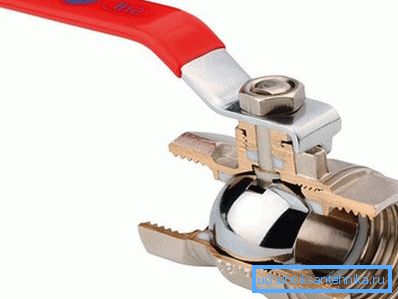
This model is currently widely used in plumbing due to the following advantages:
Merits
- Compact size, which practically do not affect the dimensions of the whole structure.
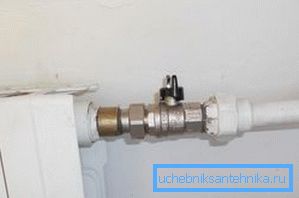
- Attractive appearance, the main fragment of which is an elegant pen.
- Affordable price. Achieved by simplicity of product design.
- High wear resistance. For manufacturing, only strong and corrosion resistant materials are used.
- Easy to use do-it-yourself. To change the mode of operation of such valves, it is enough to turn the handle 90 degrees.
Tip: It is not recommended to use a half position. The ball valve must be either open or closed, otherwise the wear of its internal part will significantly increase.
Structure
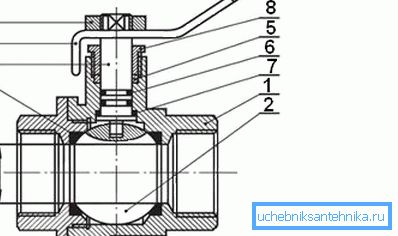
| Designation on the diagram | Title |
| one | Brass body |
| 2 | The locking ball - the main work item, created from steel |
| 3 | Saddle rings |
| four | Rod, connects the handle with the ball |
| five | Sealing gland |
| 6 | O-rings |
| 7 | Thrust washer |
| eight | Sleeve sleeve |
| 9 | The nut fixing the handle |
| ten | Handle |
Tip: when buying a ball valve, be sure to pay attention to its weight. If the product is suspiciously light, then it is likely that you have in your hands a fake, made not of brass and steel, but of silumin, which has a much shorter service life.
Principle of operation

This mechanism works very simply:
- Turns the outer handle, which is usually studded with rubber or plastic for convenience.
- This drives the rod, which is connected to the ball.
- The ball also has a through hole in the middle, which, when rotated, coincides with the outlet part of the crane.
That is, while the handle is in one position, the inside of the crane is blocked by two walls of the steel ball, and when we change its position by 90 degrees, we get an open through passage.

Purpose
The instruction involves the installation and subsequent use of ball valves with the following objectives:
- Radiator insulation to replace it or perform repairs. In this case, taps are used with two connecting pipes and mounted in the supply and discharge pipes of the coolant. Shutting them down, you completely block the access of liquid to the battery.
Advice: it is recommended to install a jumper between the pipes at the same time so that the circuit can continue to work even when the radiator is disconnected from the system.

- The withdrawal of dirty water. The fact is that after the summer idle time, the coolant in the houses is supplied incredibly dirty with many different impurities. And if you want to extend the operating period of your heating system, you need to drain the first liquid.
Ideally, this should be done for at least two days, but at least it will be enough to open the faucet for the night. For the same, to make it possible, you need to install it in advance on the edge of the battery or on the drain pipe.
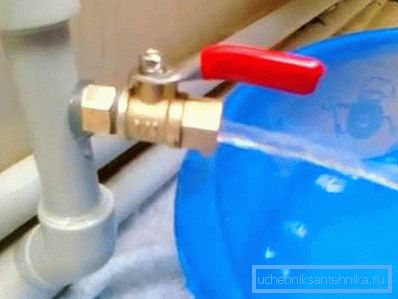
Needle crane

The Mayevsky crane has a slightly different purpose; it does not block or drain the coolant, but releases the accumulated air in the circuit, which prevents the effective operation of the heating system. Such an operation is required in the following cases:
| Situation | The reasons for its occurrence |
| Start of operation of the heating structure | After the pipeline is assembled, a certain amount of air masses will remain in its components, which by themselves will not leave the closed system. |
| Starting heating after summer downtime | There is always some air content in the water, which during a long state of rest will collect in the upper part, forming a plug |
| Long operational period | Corrosive processes inside the pipes provoke the release of hydrogen, which requires mandatory periodic elimination. |
Exploitation
If one of the above situations takes place, and the air valve is installed, then you should do this:
- Prepare the tank in case of a flow of water.
- Turning off centrifugal pumps, if any.
- Use a screwdriver or a key to turn the working part of the product counterclockwise one turn.
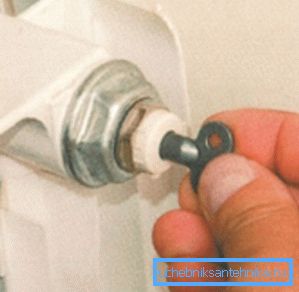
- After that, with a characteristic hiss, the accumulated air begins to escape. If its quantity is too large, further adjustment of the tap on the radiator is allowed in order to enhance the outgoing gas flow.
- After the sound stops, and water begins to drip from the tap, close it.
There are also automatic models that, although they are more expensive, but do not need to force the descent of gas accumulations, but perform this task independently.
Assembly work
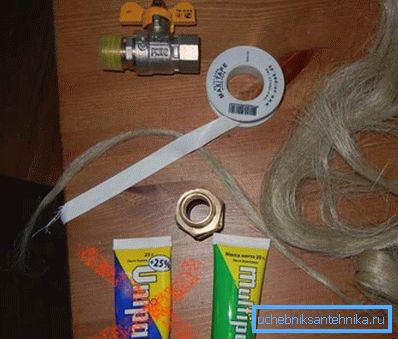
How to install a tap on the battery yourself? This will require the valves themselves, pipe wrench, tow or FUM tape, and in some cases may require a die and a "Bulgarian".
Installation of the crane on the heating battery is carried out as follows:
- Shut off the water in the system.
- Choosing valves of suitable diameter.
- If the assembly of the pipeline is just beginning and the thread at the ends of the pipes in front of the radiator is cut, as on the nozzle of the battery itself, then immediately proceed to wrapping it with tow or FUM tape. This should be done as long as the faucet is not wound with difficulty.
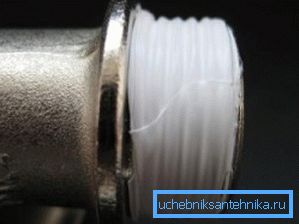
- If replacement of taps on radiators or installation on a “bare” pipe is carried out, then the task becomes a little more complicated:
- We unscrew the old product with a pipe wrench and check the condition of the threaded connection, since it is most susceptible to corrosion. If his condition is unsatisfactory, then we cut him off with a “grinder,” otherwise, then do not ask yourself: “Who is to blame if the tap on the battery is blown off?”. We also do it in the case when the crane itself is rusted so much that it cannot be unscrewed.
- We make a new thread with a die for pipes.
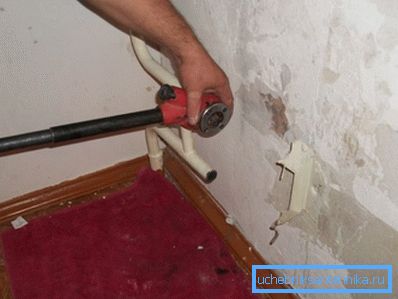
- After which we perform sealing as described above.
- We wind the valve in accordance with the arrow on the body, which indicates the direction of movement of the coolant. We adjust its position with an adjustable wrench until it stops.
- Check if anything interferes with the full rotation of the handle.
- Turn on the system and test the valves.
If a tap on the battery suddenly drains, then:
- To begin, just try to tighten the thread.
- If there is no elimination of the leak, turn off the heating again and unscrew the product. The new part will come off easily and it just will not have to be cut.
- Rewind FUM tape. We rewind it, because the old seal has already lost its tightness after removing the valve from the thread.
- Twist again all the way, using a pipe wrench.
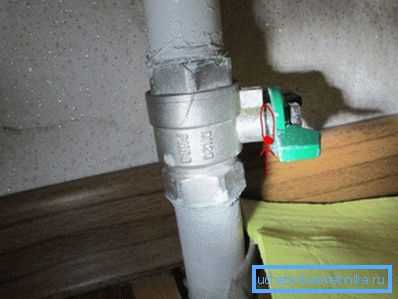
Conclusion
The heating radiator must be equipped with taps. Sharovy is responsible for isolating the section and draining the dirty coolant, and the needle one - for removing air plugs. Such simple additions to your battery will significantly improve its efficiency and operational life.
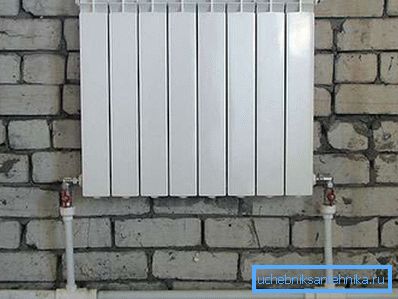
The video in this article will bring to your attention for some additional consideration some materials that are directly related to the topic outlined. Take care of the efficient operation of the batteries in your home in advance.